HADITH ABOUT TAIL BONE
The body decays except for the "tailbone".
A picture of the pelvic bones, showing the (coccyx) bone.
In a number of the noble prophetic hadiths, the coccyx was mentioned as the part of the fetus from which its body is created, and which remains after its death and the destruction of its body; to be resurrected from it again. The Chosen One (may God bless him and grant him peace) indicated that the entire human body decays except for the coccyx, so if God Almighty wants to resurrect people, He sends down rain from the sky and each individual grows from his coccyx just as a plant grows from its seed.
Among these numerous hadiths, Abu Hurairah (may Allah be pleased with him) narrated on the authority of the Messenger of Allah (may Allah bless him and grant him peace): “The earth will eat every son of Adam except the coccyx, from which he was created and on which he will be resurrected.” Narrated by (Abu Dawud, An-Nasa’i, Ahmad, Ibn Majah, Ibn Hibban, Malik).
In a narration by Abu Sa’id Al-Khudri (may Allah be pleased with him) on the authority of the Messenger of Allah
(may Allah bless him and grant him peace), he said: “The earth will eat every part of a human being except the coccyx. It was said: What is the coccyx, O Messenger of Allah? He said: Like a mustard seed from which he grew.” Imam Muslim included in his Sahih on the authority of Abu Hurairah a similar text in which he said: “The earth will eat every son of Adam except the coccyx, from which creation will be resurrected on the Day of Resurrection.”
In another version of Muslim, it is also stated in this text: “There is a bone in man that the earth will never eat, and in it he will be rebuilt on the Day of Resurrection. They said: What bone is it, O Messenger of God? He said: The coccyx.” And in a third version of Muslim, on the authority of Abu Hurairah, he said: The Messenger of God (may God bless him and grant him peace) said: “Between the two blasts there will be forty.” They said: O Abu Hurairah, forty days? He said: I refuse. They said: Forty months? He said: I refuse. They said: Forty years? He said: I refused. He said: Then Allah sends down water from the sky and they grow, just as plants grow. He said: “And there is nothing in man that does not decay, except for one bone, which is the coccyx, and from it creation will be assembled on the Day of Resurrection.”
The meaning of “I refused” in the words of Abu Hurairah is that I refused to assert that what is meant is forty days, or a month, or a year. Rather, what I assert is that it is forty in general, and forty years came in detail in a statement by al-Nawawi.
These noble prophetic hadiths contain a scientific fact that acquired sciences did not reach knowledge of until a few years ago, when specialists in embryology proved that the human body originates from a very thin strip called the “primary strip” which is created by the power of the Creator (Glory be to Him) on the fifteenth day after the fertilization of the egg and its implantation in the wall of the uterus. After its appearance, the fetus is formed with all its layers, especially the nervous system and the beginnings of the formation of the spine and the rest of the organs of the body; because Allah Almighty has given this thin strip the ability to stimulate cells to divide, specialize, differentiate and assemble into specialized tissues. And the members are integrated in their cooperation to perform all the functions of the body.
It has been proven that this primary strip disappears except for a small part of it, which remains at the end of the spine ( the coccyx ) , which is what is meant by the tailbone in the hadiths of the Messenger of Allah (may Allah bless him and grant him peace). When a person dies, his entire body decays except for the tailbone, which the hadiths of the Messenger of Allah (may Allah bless him and grant him peace) mention, that the person is recreated from it by the descent of a special rain from the sky, which our Lord (Blessed and Exalted be He) sends down when He wills, so that every creature grows from the tailbone, just as a plant grows from its seed.
A group of Chinese scientists have proven in a number of laboratory experiments the impossibility of annihilating the tailbone ( the end of the coccyx ).Chemically by dissolving in the strongest acids, or physically by burning, crushing, or exposing to various rays, which confirms the truth of the hadith of the Chosen One (may Allah's prayers and peace be upon him), which is considered a precedent for all acquired sciences by at least one thousand four hundred years.
Here an important question comes to mind: Why did the Chosen One (may Allah's prayers and peace be upon him) address such a scientific and metaphysical issue at a time when no creature had knowledge of it? And where did this final prophet and final messenger get this knowledge from if he was not connected to revelation and taught by the Creator of the heavens and the earth?
To answer this, we say that God Almighty knows with His comprehensive knowledge that man will one day reach the knowledge of the stages of the fetus, and will clarify the role of the primary strip, one of the remains of which is the coccyx, in the creation of the fetus’s body. So He inspired the Seal of His Prophets and Messengers to utter this truth so that it would remain as evidence of the truth of his prophethood, the truth of his message, and the truth of his receipt from the Creator, Glory be to Him, the Most High, which would remain appropriate for every time and every age. And since our time has been distinguished by a degree of scientific discoveries and technical developments that were not available – as far as we know – for any previous time, then such scientific indications in both the Book of God and the Sunnah of His Messenger (may God bless him and grant him peace) remain the language and discourse of the age, and the method of calling to the religion of the Seal of God, who does not accept any religion from His servants other than it. So no sane person can imagine a source for this scientific truth from a thousand and four hundred years ago other than a true revelation from God, the Creator ??!!
Among these numerous hadiths, Abu Hurairah (may Allah be pleased with him) narrated on the authority of the Messenger of Allah (may Allah bless him and grant him peace): “The earth will eat every son of Adam except the coccyx, from which he was created and on which he will be resurrected.” Narrated by (Abu Dawud, An-Nasa’i, Ahmad, Ibn Majah, Ibn Hibban, Malik).
In a narration by Abu Sa’id Al-Khudri (may Allah be pleased with him) on the authority of the Messenger of Allah
(may Allah bless him and grant him peace), he said: “The earth will eat every part of a human being except the coccyx. It was said: What is the coccyx, O Messenger of Allah? He said: Like a mustard seed from which he grew.” Imam Muslim included in his Sahih on the authority of Abu Hurairah a similar text in which he said: “The earth will eat every son of Adam except the coccyx, from which creation will be resurrected on the Day of Resurrection.”
In another version of Muslim, it is also stated in this text: “There is a bone in man that the earth will never eat, and in it he will be rebuilt on the Day of Resurrection. They said: What bone is it, O Messenger of God? He said: The coccyx.” And in a third version of Muslim, on the authority of Abu Hurairah, he said: The Messenger of God (may God bless him and grant him peace) said: “Between the two blasts there will be forty.” They said: O Abu Hurairah, forty days? He said: I refuse. They said: Forty months? He said: I refuse. They said: Forty years? He said: I refused. He said: Then Allah sends down water from the sky and they grow, just as plants grow. He said: “And there is nothing in man that does not decay, except for one bone, which is the coccyx, and from it creation will be assembled on the Day of Resurrection.”
The meaning of “I refused” in the words of Abu Hurairah is that I refused to assert that what is meant is forty days, or a month, or a year. Rather, what I assert is that it is forty in general, and forty years came in detail in a statement by al-Nawawi.
These noble prophetic hadiths contain a scientific fact that acquired sciences did not reach knowledge of until a few years ago, when specialists in embryology proved that the human body originates from a very thin strip called the “primary strip” which is created by the power of the Creator (Glory be to Him) on the fifteenth day after the fertilization of the egg and its implantation in the wall of the uterus. After its appearance, the fetus is formed with all its layers, especially the nervous system and the beginnings of the formation of the spine and the rest of the organs of the body; because Allah Almighty has given this thin strip the ability to stimulate cells to divide, specialize, differentiate and assemble into specialized tissues. And the members are integrated in their cooperation to perform all the functions of the body.
It has been proven that this primary strip disappears except for a small part of it, which remains at the end of the spine ( the coccyx ) , which is what is meant by the tailbone in the hadiths of the Messenger of Allah (may Allah bless him and grant him peace). When a person dies, his entire body decays except for the tailbone, which the hadiths of the Messenger of Allah (may Allah bless him and grant him peace) mention, that the person is recreated from it by the descent of a special rain from the sky, which our Lord (Blessed and Exalted be He) sends down when He wills, so that every creature grows from the tailbone, just as a plant grows from its seed.
A group of Chinese scientists have proven in a number of laboratory experiments the impossibility of annihilating the tailbone ( the end of the coccyx ).Chemically by dissolving in the strongest acids, or physically by burning, crushing, or exposing to various rays, which confirms the truth of the hadith of the Chosen One (may Allah's prayers and peace be upon him), which is considered a precedent for all acquired sciences by at least one thousand four hundred years.
Here an important question comes to mind: Why did the Chosen One (may Allah's prayers and peace be upon him) address such a scientific and metaphysical issue at a time when no creature had knowledge of it? And where did this final prophet and final messenger get this knowledge from if he was not connected to revelation and taught by the Creator of the heavens and the earth?
To answer this, we say that God Almighty knows with His comprehensive knowledge that man will one day reach the knowledge of the stages of the fetus, and will clarify the role of the primary strip, one of the remains of which is the coccyx, in the creation of the fetus’s body. So He inspired the Seal of His Prophets and Messengers to utter this truth so that it would remain as evidence of the truth of his prophethood, the truth of his message, and the truth of his receipt from the Creator, Glory be to Him, the Most High, which would remain appropriate for every time and every age. And since our time has been distinguished by a degree of scientific discoveries and technical developments that were not available – as far as we know – for any previous time, then such scientific indications in both the Book of God and the Sunnah of His Messenger (may God bless him and grant him peace) remain the language and discourse of the age, and the method of calling to the religion of the Seal of God, who does not accept any religion from His servants other than it. So no sane person can imagine a source for this scientific truth from a thousand and four hundred years ago other than a true revelation from God, the Creator ??!!
Glory be to Him who created and perfected, and taught and taught, and revealed to the Seal of His Prophets and Messengers the truth which falsehood cannot approach from before it or from behind it, and may God’s prayers and peace be upon our Master Muhammad and upon his family and companions and those who followed his guidance and called to his message until the Day of Judgment
1- The Messenger of Allah , may Allah bless him and grant him
peace, said : “Then water will descend from the sky and they will grow as vegetables grow, and there will be nothing in man that will not decay except for one bone, which is the coccyx.” Narrated by Al-Bukhari, Muslim, Malik in Al-Muwatta’, Abu Dawud, and Al-Nasa’i. 2- On the authority of Abu Hurairah, may Allah be pleased with him, that the Messenger of Allah, may Allah bless him and grant him peace, said: “Every son of Adam will be eaten by the dust except the coccyx, from which he was created and in which he will be resurrected.” Narrated by Al-Bukhari, Al-Nasa’i, Abu Dawud, Ibn Majah, Ahmad in Al-Musnad, and Malik in Al-Muwatta’.
peace, said : “Then water will descend from the sky and they will grow as vegetables grow, and there will be nothing in man that will not decay except for one bone, which is the coccyx.” Narrated by Al-Bukhari, Muslim, Malik in Al-Muwatta’, Abu Dawud, and Al-Nasa’i. 2- On the authority of Abu Hurairah, may Allah be pleased with him, that the Messenger of Allah, may Allah bless him and grant him peace, said: “Every son of Adam will be eaten by the dust except the coccyx, from which he was created and in which he will be resurrected.” Narrated by Al-Bukhari, Al-Nasa’i, Abu Dawud, Ibn Majah, Ahmad in Al-Musnad, and Malik in Al-Muwatta’.
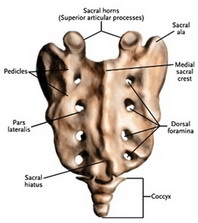
Figure 1: The coccyx is a group of atrophied vertebrae at the end of the spine.
The following facts can be concluded from the previous authentic hadiths:
1- The coccyx is a basic component from which the fetus is created in its early stages.
2- The coccyx does not decay.
3- From it creation will be assembled on the Day of Resurrection.
The scientific proof of the first conclusion (the coccyx is a basic component of which the fetus is formed in its early stages) is sufficient to accept the third conclusion (in it creation is formed on the Day of Resurrection), which is certainly from the unseen that cannot be delved into. There is evidence for many things in this, including:
1- Evidence that resurrection is true, and an example of this is in the Holy Quran, where God Almighty says:
{O mankind, if you are in doubt about the Resurrection - then indeed We created you from dust, then from a sperm-drop, then from a clinging clot, then from a lump of flesh, formed and unformed, that We may make clear to you. And We settle in the wombs whom We will for a specified term, then they will die.} {We bring you forth as a child, then [you will] reach your full strength. And among you is he who is taken [in death], and among you is he who is returned to the most decrepit old age, so that he does not know, after [having] knowledge, a thing. And you see the earth barren, but when We send down upon it rain, it quivers and swells and grows [abundantly] of every beautiful pair.} [Al-Hajj: 5]
So since what the verses have reported about cosmic matters that were unseen at the time of revelation has been established, it is necessary to establish what they have reported about matters that are still unseen regarding the Hereafter, and thus doubt about the Resurrection is eliminated.
2- Evidence of the prophethood of the Messenger, may God bless him and grant him peace, as his hadith has been proven to be true.
3- Evidence of the soundness of the approach of the predecessors of this nation in the soundness of transmission from the Messenger of God, may God bless him and grant him peace, until the noble prophetic hadiths reached us as he, may God bless him and grant him peace, told us about them.
Muslim scholars in the second half of the twentieth century built their understanding of the miracle in this hadith of the coccyx on two basic scientific foundations:
1- That the coccyx is what remains of the first part of the fetus known as (the primitive streak), which is a pivotal part known to appear in the early third week and cells from the ectoderm layer pass through it to form the mesoderm layer, then it shrinks (the primitive streak) and what remains of it is reduced to small parts that are represented in humans in the coccyx vertebrae (Figure 1).
2- Evidence of the origin of the ability of this part to form different tissues in the body is that in the event of a tumor occurring in this part of a newborn child (teratoma), this tumor contains samples of all the different tissues of the body (hair - teeth - glands - .....) (Figure 2).
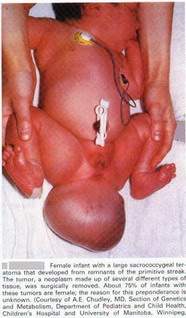
3- On the authority of Abu Hurairah, may God be pleased with him, on the authority of the Messenger of God, may God bless him and grant him peace, “Indeed, in man there is a bone that the earth will never consume, and in it he will be rebuilt on the Day of Resurrection.” They said, “Which bone, O Messenger of God?” He said, “The coccyx. ” Narrated by Al-Bukhari, Al-Nasa’i, Abu Dawud, Ibn Majah, and Ahmad in Al-Musnad, and it was included by Malik.
The following facts can be concluded from the previous authentic hadiths:
1- The coccyx is a basic component from which the fetus is created in its early stages.
2- The coccyx does not decay.
3- From it creation will be assembled on the Day of Resurrection.
The scientific proof of the first conclusion (the coccyx is a basic component of which the fetus is formed in its early stages) is sufficient to accept the third conclusion (in it creation is formed on the Day of Resurrection), which is certainly from the unseen that cannot be delved into. There is evidence for many things in this, including:
1- Evidence that resurrection is true, and an example of this is in the Holy Quran, where God Almighty says:
{O mankind, if you are in doubt about the Resurrection - then indeed We created you from dust, then from a sperm-drop, then from a clinging clot, then from a lump of flesh, formed and unformed, that We may make clear to you. And We settle in the wombs whom We will for a specified term, then they will die.} {We bring you forth as a child, then [you will] reach your full strength. And among you is he who is taken [in death], and among you is he who is returned to the most decrepit old age, so that he does not know, after [having] knowledge, a thing. And you see the earth barren, but when We send down upon it rain, it quivers and swells and grows [abundantly] of every beautiful pair.} [Al-Hajj: 5]
So since what the verses have reported about cosmic matters that were unseen at the time of revelation has been established, it is necessary to establish what they have reported about matters that are still unseen regarding the Hereafter, and thus doubt about the Resurrection is eliminated.
2- Evidence of the prophethood of the Messenger, may God bless him and grant him peace, as his hadith has been proven to be true.
3- Evidence of the soundness of the approach of the predecessors of this nation in the soundness of transmission from the Messenger of God, may God bless him and grant him peace, until the noble prophetic hadiths reached us as he, may God bless him and grant him peace, told us about them.
Muslim scholars in the second half of the twentieth century built their understanding of the miracle in this hadith of the coccyx on two basic scientific foundations:
1- That the coccyx is what remains of the first part of the fetus known as (the primitive streak), which is a pivotal part known to appear in the early third week and cells from the ectoderm layer pass through it to form the mesoderm layer, then it shrinks (the primitive streak) and what remains of it is reduced to small parts that are represented in humans in the coccyx vertebrae (Figure 1).
2- Evidence of the origin of the ability of this part to form different tissues in the body is that in the event of a tumor occurring in this part of a newborn child (teratoma), this tumor contains samples of all the different tissues of the body (hair - teeth - glands - .....) (Figure 2).

Figure 2: A tumor emerging from the coccygeal region in a newborn girl containing samples of all different body tissues (Moore and Persaud, 1998, P: 66)basic points that represent, in their entirety, what is new in understanding the formation of the coccyx in the embryonic stage:
1) The first point:
a) The fertilized egg begins successive divisions from the beginning of fertilization that occurs at the outer end of the fallopian tube, passing through the two-, four-, eight-, and sixteen-cell stages (the beginning of the thymus stage that enters the uterus), then the blastocyst stage, which consists of an outer layer of cells (which form the membranes surrounding the fetus and which will participate with some tissues from the mother in forming the placenta) and an inner mass of cells (which will be responsible for forming the fetus itself) (Figures 4 and 3).
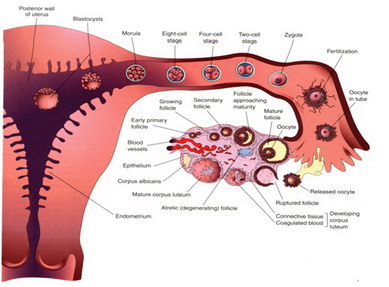
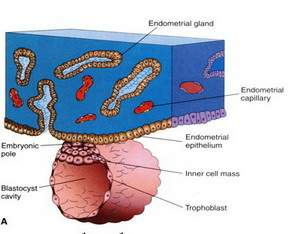
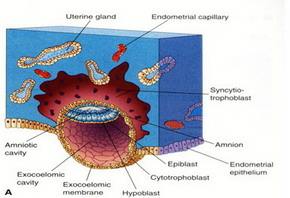
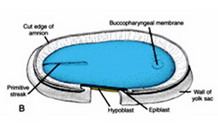
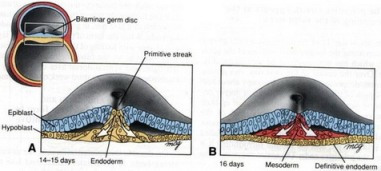
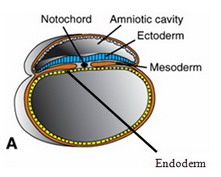
1) The first point:
a) The fertilized egg begins successive divisions from the beginning of fertilization that occurs at the outer end of the fallopian tube, passing through the two-, four-, eight-, and sixteen-cell stages (the beginning of the thymus stage that enters the uterus), then the blastocyst stage, which consists of an outer layer of cells (which form the membranes surrounding the fetus and which will participate with some tissues from the mother in forming the placenta) and an inner mass of cells (which will be responsible for forming the fetus itself) (Figures 4 and 3).

Figure (3): Shows the developments that occur during the first week of fertilization, which include the successive divisions of the fertilized egg as it passes through the fallopian tube to the upper region of the uterus. The figure shows the stages of the fertilized egg, the two-cell, four-cell, eight-cell, and sixteen-cell (the beginning of the thymus stage) that enter the uterus with repeated division until the stage (The blastocyst), which implants in the lining of the uterus (Moore and Persaud, 1998, P: 44).

Figure 4: The blastocyst stage consisting of an outer layer of cells (to form the embryonic membranes) and an inner mass of cells (to form the embryo itself) which is the implantation stage (Moore and Persauaud, 1998, P:43)
b) The old description of the development of the inner mass of cells in the blastocyst stage into two layers (Ectoderm & Endoderm) is no longer scientifically valid. However, the distinction is first made into two primary layers, upper and lower, known as (Epiblast & Hypoblast) at the beginning of the second week (Figure-5).
b) The old description of the development of the inner mass of cells in the blastocyst stage into two layers (Ectoderm & Endoderm) is no longer scientifically valid. However, the distinction is first made into two primary layers, upper and lower, known as (Epiblast & Hypoblast) at the beginning of the second week (Figure-5).

Figure 5: The figure shows the differentiation of the inner layer of blastocyst cells into two primary layers, the upper and lower, known as the Epiblast and Hypoblast (Moore & Persauaud, 1998, P: 49)
c) At the beginning of the third week, a new formation appears in the Epiblast layer, which is the Primitive streak (Figure 6).
c) At the beginning of the third week, a new formation appears in the Epiblast layer, which is the Primitive streak (Figure 6).

Figure (6): A picture showing the formation of (The primitive streak) in the epiblast layer. At the end of the second week and the beginning of the third week. Sadler, 2000, P: 62)
d) The epiblast cells multiply and the interconnection between them decreases, then they pass through (The Primitive Streak) to replace first the cells of the Hypoblast layer and form the Endoderm tissue, then the interstitial cells spread to form the Mesoderm tissue. From this time on, the epiblast layer is called the ectoderm, and thus the three known layers of the embryo (Ectoderm, Mesoderm and Endoderm) are formed from one primary layer, which is the Epiblast layer. The basis for the formation of the cells of the layers is their passage through (The Primitive Streak). This new explanation is completely consistent with the understanding of the noble hadith that man was (created) from the coccyx (or the origin of the coccyx), as the hadith is within the framework of the formation stage, and the basis for the formation of the cells of the layers is their passage through (The Primitive Streak) (Figure 8, 97).
d) The epiblast cells multiply and the interconnection between them decreases, then they pass through (The Primitive Streak) to replace first the cells of the Hypoblast layer and form the Endoderm tissue, then the interstitial cells spread to form the Mesoderm tissue. From this time on, the epiblast layer is called the ectoderm, and thus the three known layers of the embryo (Ectoderm, Mesoderm and Endoderm) are formed from one primary layer, which is the Epiblast layer. The basis for the formation of the cells of the layers is their passage through (The Primitive Streak). This new explanation is completely consistent with the understanding of the noble hadith that man was (created) from the coccyx (or the origin of the coccyx), as the hadith is within the framework of the formation stage, and the basis for the formation of the cells of the layers is their passage through (The Primitive Streak) (Figure 8, 97).

Figure 7: The figure shows the migration of epiblast cells through the primitive streak, where its cells first replace the hypoblast cells on the fourteenth and fifteenth day, forming a new tissue called the ectoderm. Then, on the sixteenth day, these migrating cells fill the space between the epiblast and endoderm layers, forming a new tissue known as intraembryonic mesoderm (Larsen, 1993, P:50).

Figure 8: The figure shows the three embryonic layers after the end of the cell migration stage from the epiblast layer. The three layers are (Ectoderm, Mesoderm and Endoderm). The basis for the formation of the cells of the layers is their passage through (The Primitive streak) (Sadler, 2000, P: 91).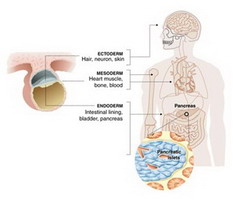
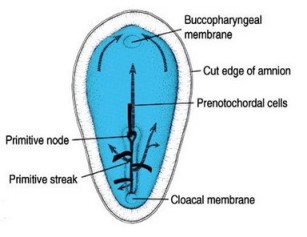
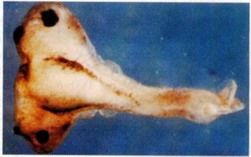
Contrary to what was previously known, this body (caudal eminence) is responsible for forming not only the coccyx but also the basic parts of the spine, the spinal cord, and the membranes surrounding it below the level of L2. This is a fourth confirmation of the truth of his saying, may God bless him and grant him peace, “From it he was created.” (Figure 12).
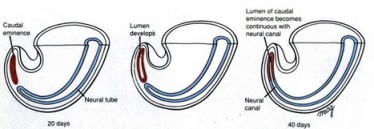
However, there is an overwhelming feeling in the soul that the wonders of this hadith are not over yet, and perhaps what we do not know is much more than what we know.
Many research points have been assumed that need to be explored, including:
1) Does anything in the coccyx bone wear out?
2) Does the coccyx bone resist physical factors in a way that other bones do not?
3) Is there a difference in the structure at any level that distinguishes this bone from other bones (biochemistry-molecular)?
This research may be difficult from the point of view of medical ethics, as conducting it may not be justified from a medical point of view. However, if it is proven in Sharia that the aforementioned resurrection method applies to the ******** as it applies to humans, then research can be conducted on ******** experiments.
However, the researcher in this field must be aware that assuming that the coccyx bone will remain completely without wear and tear is an understanding that may or may not agree with the intent of the hadith. There may be a degree of greatness (we do not know its amount) that does not disappear. The noble Hadith is in the Arabic language and it contains general and partial relationships, particularity and generality between words, as God Almighty said : {It destroys everything by the command of its Lord, so nothing is seen except their dwellings. Thus do We recompense the criminal people} Al-Ahqaf 25. That is, everything that God Almighty ordered it to destroy, otherwise it would not have destroyed the earth, the heavens and the planets.
In any case, the existence of evidence of the distinction of the cells of the coccyx region from other cells is considered a direct positive result in this area.
One of the good tidings of this is what was announced by a research team from the University of Michigan in the United States of America - which includes Muslim and non-Muslim researchers - (Ben Chen and Ramzi Mohamad) - at the Eighth Conference on the Scientific Miracles in the Quran and Sunnah in Kuwait in Dhul-Qi'dah 1427 AH, through a research entitled:
MIRACULOUS DE******ION ABOUT THE VREATION OF HUMAN BODIES (AND NOT SOUL) FROM TAIL BONE IN THE DAY OF RESURRECTION.
They obtained preliminary results that the stem cells in the coccyx area have distinctive characteristics from other stem cells in different areas of the body.
This preliminary result opens the door to dozens of scientific questions, some of which this scientific team has already begun planning to do.
The goal here is to arouse the scientific enthusiasm of specialists to contribute their two cents, whether by collecting documented scientific material that clarifies the scope of the miracle in this hadith or by conducting documented scientific experiments through which the researcher - if his intentions are sincere - will gain precedence in this world and the hereafter, God willing.
References:
Larsen J. William . Human Embryology. Churchill Livingstone. 1st ed., 1993.
Moore L. Keith and Persaud TVN Before we are born. Sanders Company. 5th ed., 1998.
Sadler TW Langman's Medical Embryology. Lippincott Williams & Wilkins. 8th ed., 2000.
Dr. Mustafa Abdel Moneim
Professor of Embryology and Anatomy
Faculty of Medicine - Taibah University
Madinah - P.O. Box: 30001
moustmon@yahoo.com

Figure 9: The figure shows the basic tissues that will result from the division and differentiation of cells of the three layers (Ectoderm, Mesoderm and Endoderm)
Second point: When cells pass through (The Primitive streak), each cell passes through a specific place in it while crossing to form the cells of the (The Mesoderm) layer, heading to a completely specific place in this new layer. This can be explained by a kind of programming of the cells when they pass through (The Primitive streak), and this precise prior estimation made it possible to draw an accurate map of the direction of the cells according to the place of their passage in (The Primitive streak), which is known as the Fate map (Sadler, 2000). Figure 10 This is another confirmation of the hadith (From Him was created).
Second point: When cells pass through (The Primitive streak), each cell passes through a specific place in it while crossing to form the cells of the (The Mesoderm) layer, heading to a completely specific place in this new layer. This can be explained by a kind of programming of the cells when they pass through (The Primitive streak), and this precise prior estimation made it possible to draw an accurate map of the direction of the cells according to the place of their passage in (The Primitive streak), which is known as the Fate map (Sadler, 2000). Figure 10 This is another confirmation of the hadith (From Him was created).

Figure 10: The figure clearly shows the inevitability of the path of the cell migration line according to its crossing point (primitive streak), which shows the occurrence of a type of programming or determining the path for each cell according to its crossing point to head to a specific place in the embryo and for each cell to divide after that and differentiate into a specific type of cell. (Sadler, 2000, P:64)
The third point: Transferring the (Blastopore) from one frog embryo to another, which is a structure similar to some parts of the (Primitive streak) in humans, results in the formation of another new embryo attached to the first embryo in the form of Siamese twins (Complete Siamese). This is a third confirmation of the noble hadith (From Him He was created). (Figure 11).

Figure 11: The figure shows the formation of a new complete embryo attached to the transfer of the blastopore region from one frog embryo to another. Larsen, 1993, P: 89
Fourth point: When studying in general international references, the researcher may become frustrated when he sees the consensus of these references that (Primitive streak) disappears at the end of the third week or the middle of the fourth week of fetal development, which means blowing up all the previous conception. But the truth is that (Primitive streak) before disappearing leaves a child known as (Caudal eminence) in the (Mesoderm) area, then the Primitive streak itself disappears completely, and the remaining of some (Primitive streak) in the ectoderm area is clearly what leads to the formation of the malignant tumor known as (teratoma), which is the most famous malignant tumor in children ever.
Contrary to what was previously known, this body (caudal eminence) is responsible for forming not only the coccyx but also the basic parts of the spine, the spinal cord, and the membranes surrounding it below the level of L2. This is a fourth confirmation of the truth of his saying, may God bless him and grant him peace, “From it he was created.” (Figure 12).

Figure 12: The figure shows the formation of a caudal eminence that will be responsible, before the end of the sixth week, for the formation of the sacrum, the spinal cord, and the membranes surrounding it below the level of L2. (Larsan, 1993, P: 76)
Each of the four points mentioned above individually bears evidence of the truth of the miraculous hadith of the Messenger of Allah, may Allah bless him and grant him peace, regarding the wonder of the coccyx. So what about them together? Do we not have the right to present to the world, through this hadith, new evidence of the truth of his message, may Allah bless him and grant him peace, establishing the argument against them (so that he who perishes will perish on the basis of clear evidence and he who lives will live on the basis of clear evidence)?
However, there is an overwhelming feeling in the soul that the wonders of this hadith are not over yet, and perhaps what we do not know is much more than what we know.
Many research points have been assumed that need to be explored, including:
1) Does anything in the coccyx bone wear out?
2) Does the coccyx bone resist physical factors in a way that other bones do not?
3) Is there a difference in the structure at any level that distinguishes this bone from other bones (biochemistry-molecular)?
This research may be difficult from the point of view of medical ethics, as conducting it may not be justified from a medical point of view. However, if it is proven in Sharia that the aforementioned resurrection method applies to the ******** as it applies to humans, then research can be conducted on ******** experiments.
However, the researcher in this field must be aware that assuming that the coccyx bone will remain completely without wear and tear is an understanding that may or may not agree with the intent of the hadith. There may be a degree of greatness (we do not know its amount) that does not disappear. The noble Hadith is in the Arabic language and it contains general and partial relationships, particularity and generality between words, as God Almighty said : {It destroys everything by the command of its Lord, so nothing is seen except their dwellings. Thus do We recompense the criminal people} Al-Ahqaf 25. That is, everything that God Almighty ordered it to destroy, otherwise it would not have destroyed the earth, the heavens and the planets.
In any case, the existence of evidence of the distinction of the cells of the coccyx region from other cells is considered a direct positive result in this area.
One of the good tidings of this is what was announced by a research team from the University of Michigan in the United States of America - which includes Muslim and non-Muslim researchers - (Ben Chen and Ramzi Mohamad) - at the Eighth Conference on the Scientific Miracles in the Quran and Sunnah in Kuwait in Dhul-Qi'dah 1427 AH, through a research entitled:
MIRACULOUS DE******ION ABOUT THE VREATION OF HUMAN BODIES (AND NOT SOUL) FROM TAIL BONE IN THE DAY OF RESURRECTION.
They obtained preliminary results that the stem cells in the coccyx area have distinctive characteristics from other stem cells in different areas of the body.
This preliminary result opens the door to dozens of scientific questions, some of which this scientific team has already begun planning to do.
The goal here is to arouse the scientific enthusiasm of specialists to contribute their two cents, whether by collecting documented scientific material that clarifies the scope of the miracle in this hadith or by conducting documented scientific experiments through which the researcher - if his intentions are sincere - will gain precedence in this world and the hereafter, God willing.
References:
Larsen J. William . Human Embryology. Churchill Livingstone. 1st ed., 1993.
Moore L. Keith and Persaud TVN Before we are born. Sanders Company. 5th ed., 1998.
Sadler TW Langman's Medical Embryology. Lippincott Williams & Wilkins. 8th ed., 2000.
Dr. Mustafa Abdel Moneim
Professor of Embryology and Anatomy
Faculty of Medicine - Taibah University
Madinah - P.O. Box: 30001
moustmon@yahoo.com
addition to this topic,
especially a number of Western scientists conducted a number of experiments and researches on the coccyx. Among these scientists was the German scientist Hans Spemann, who began studying the coccyx in amphibians since 1931. In his experiments, he planted the primary embryo, as he called it, in an embryo, and a secondary embryo grew. Then he crushed the coccyx and did the same experiment, and a secondary embryo grew. He also boiled it, and another secondary embryo emerged. This doctor won the Nobel Prize for his discovery of the PRIMITIVE STREAK in 1935 AD.

To learn more about this scientist and what he did, you can enter through this link: -

b. In a larger percentage, only one blastomere gave a normal embryo, while the other half remained unorganized, though viable, round structure.
2. Prepare the embryo – Observe the eggs, waiting for the first cleavage that occurs about 8 – 10 hours after fertilization.

5. After constriction is finished, cut off the free ends of the loop near the egg.
especially a number of Western scientists conducted a number of experiments and researches on the coccyx. Among these scientists was the German scientist Hans Spemann, who began studying the coccyx in amphibians since 1931. In his experiments, he planted the primary embryo, as he called it, in an embryo, and a secondary embryo grew. Then he crushed the coccyx and did the same experiment, and a secondary embryo grew. He also boiled it, and another secondary embryo emerged. This doctor won the Nobel Prize for his discovery of the PRIMITIVE STREAK in 1935 AD.
To learn more about this scientist and what he did, you can enter through this link: -
This is one of his famous researches in this field under the title of embryo production and twins:
The Production of Twin Embryos and of Duplications in Urodeles by Constriction
Spemann
Hans Spemann was born on June 27, 1869, in Stuttgart Germany. German embryologist who was awarded the Nobel Prize for Physiology or Medicine in 1935 for his discovery of the effect now known as embryonic induction, the influence exercised by various parts of the embryo that directs the development of groups of cells into particular tissues and organs.
Spemann, initially a medical student, attended the universities of Heidelberg, Munich, and Wurzburg and graduated in zoology, botany, and physics. He worked at the Zoological Institute of Wurzburg (1894-1908), held a professorship at Rostock (1908-14), was director of the Kaiser Wilhelm Institute for Biology in Berlin (1914-19), and occupied the chair of zoology at Freiburg (1919-35).
Spemann's concept of induction was based upon a lifetime of research into the early development of the newt. His work showed that, in the earliest stages, the fate of the embryonic parts has not been determined: if a piece of presumptive skin tissue is excised and transplanted into an area of presumptive nervous tissue, it will form nervous tissue, not skin. These results illuminate not only normal processes of development but also the origin of congenital abnormalities. Spemann summarized his researches in Experimentelle Beitrage zu einer Theorie der Entwicklung (1936; Embryonic Development and Induction).
ــــــــــــــــــــــــــــــــــــــــــــــــــــــــــــــــــــــــــــــــــــــــــــــ
The Production of Twin Embryos and of
Duplications in Urodeles by Constriction
In the urodele, twin embryos and duplications can be obtained best by constricting the Rap 2-cell stage in the plane of first cleavage, using a baby's hair. When the 2 blastomeres were completely separated by deep constriction, the following results were obtained
a. In certain percentage of the cases, whole embryos developed. They were identical twins. They were smaller in size than normal, but otherwise normal.
b. In a larger percentage, only one blastomere gave a normal embryo, while the other half remained unorganized, though viable, round structure.
> In the first case, the cleavage plane coincided with the future median plan of the embryo. In the second case, the first cleavage plane separated future dorsal from future ventral structures, and only the dorsal half gave a normal embryo. The sphere with no axial organs was called family story the "belly piece" (Bauchstuck). This implies that, in the salamander, the first cleavage plane and the median plane of the embryo have no constant relationship. In some eggs, both isolated blastomeres shared in the blastopore and underwent gastrulation, and these eggs invariably gave rise to identical twins. In the cases, only one half of the egg majority formed a dorsal lip and gastrulated, and it was this half that developed into the complete embryo, the other forming a belly piece. Spemann concluded that as early as the 2 cell stage, the dorsal half differs from the ventral half in that it contains some property which enables it to undergo typical gastrulation and differentiation. This "dorsal quality", which is lacking in the ventral half, was later identified as the "organizer", and the constriction experiment may be considered the first step in this discovery
.
Procedure :
1. Prepare the hair for constriction, make a loop that is slightly larger than the smaller diameter of the oval capsule.
2. Prepare the embryo – Observe the eggs, waiting for the first cleavage that occurs about 8 – 10 hours after fertilization.
3.Constriction – Wait until the 2 – cell stage is well under way. Prepare the constriction as shown in the following diagram
In order to obtain complete twins, it is not necessary to constrict until the two halves are entirely separated. Such a deep constriction usually results in the bursting of the vitelline membrane and the loss of one per both halves. In order to obtain conjoined anterior duplications, constrict only slightly.
5. After constriction is finished, cut off the free ends of the loop near the egg.
6. Place eggs in a clean dish with a dilute medium.
7. Observe gastrulation. It is indicative of the future result. Twins will be obtained if the blastopore and upper lip are shared by both sides. If gastrulation in only one half, then you can conclude that the plane of constriction was frontal. The half that does not gastrulate will form a belly piece.
The most truthful promise of God and the most false balance of power

Comments
Post a Comment